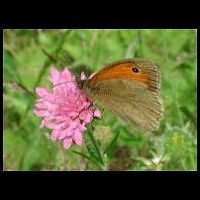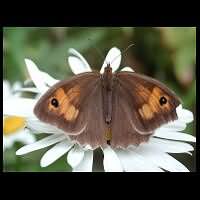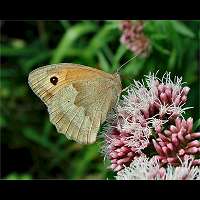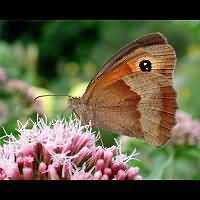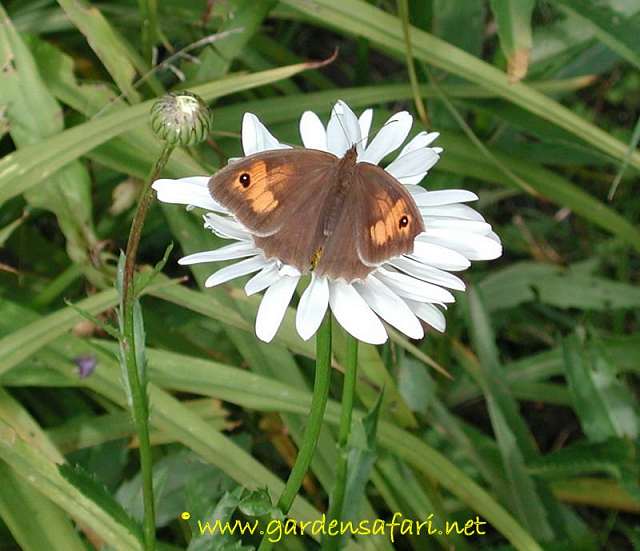Meadow Brown Maniola jurtina
The Meadow Brown is another frequent visitor to our garden. This too is a typical woodland species, commonly seen in meadows near woodlands. Just like the Ringlet it is a dark brown species (this applies to the males especially), so it often flies about unnoticed. Often we see three to five specimens in our garden at the same time. The females have a dark orange patch in their wings, the males are almost entirely dark brown. On the backside of the wings the differences are that males have less contrast than the females. That is why the animal in the top picture probably is a male. The animal in the second picture from the top definitely is a female.
The female of the Meadow Brown does look like the Gatekeeper, a related species, which we have not seen in our garden yet. In some books and on some websites the difference between the two species is often indicated to be the eye spot on the front wing. The Gatekeeper always has two white spots in the black blob and the Meadow Brown just one. So when we took our first pictures of the animal shown in the pictures in the fourth picture from above to the left, we were happy to believe it was the Gatekeeper we had been photographing, for the animal shows a beautiful 'double eye'. Unfortunately both Albert de Wilde and Tim Cowles had to correct us: double-eyed Meadow Browns really are a rarity, but they do exist. The difference between the Gatekeeper and the Meadow Brown becomes clear, studying the backside of the wings: the gatekeeper has a few small eyes there, the Meadow Brown doesn't. In Britain the Gatekeeper is common in the south of England only and is absent in Wales, Scotland and Ireland, so no worries of mixing up the species over there.
The Meadow Brown is a common species all over the British Isles. It is on the wing from May to September, even though just one brood is produced. In northern parts of Britain (noticeably Scotland) it flies in June and July only. This species is common on the continent as well and can be found not only in Europe, but in many parts of Central Asia and Northern Africa as well. In the hot southern parts of Europe and Northern Africa it oversummers. Reaching a wingspan of up to 48 mm it is clearly bigger than the previous species. The larva is green and lives on a great variety of grasses. The colour of the pupa is extremely variable: green, yellow, brown, red or even purple.
The Meadow Brown is another frequent visitor to our garden. This too is a typical woodland species, commonly seen in meadows near woodlands. Just like the Ringlet it is a dark brown species (this applies to the males especially), so it often flies about unnoticed. Often we see three to five specimens in our garden at the same time. The females have a dark orange patch in their wings, the males are almost entirely dark brown. On the backside of the wings the differences are that males have less contrast than the females. That is why the animal in the top picture probably is a male. The animal in the second picture from the top definitely is a female.
The female of the Meadow Brown does look like the Gatekeeper, a related species, which we have not seen in our garden yet. In some books and on some websites the difference between the two species is often indicated to be the eye spot on the front wing. The Gatekeeper always has two white spots in the black blob and the Meadow Brown just one. So when we took our first pictures of the animal shown in the pictures in the fourth picture from above to the left, we were happy to believe it was the Gatekeeper we had been photographing, for the animal shows a beautiful 'double eye'. Unfortunately both Albert de Wilde and Tim Cowles had to correct us: double-eyed Meadow Browns really are a rarity, but they do exist. The difference between the Gatekeeper and the Meadow Brown becomes clear, studying the backside of the wings: the gatekeeper has a few small eyes there, the Meadow Brown doesn't. In Britain the Gatekeeper is common in the south of England only and is absent in Wales, Scotland and Ireland, so no worries of mixing up the species over there.
The Meadow Brown is a common species all over the British Isles. It is on the wing from May to September, even though just one brood is produced. In northern parts of Britain (noticeably Scotland) it flies in June and July only. This species is common on the continent as well and can be found not only in Europe, but in many parts of Central Asia and Northern Africa as well. In the hot southern parts of Europe and Northern Africa it oversummers. Reaching a wingspan of up to 48 mm it is clearly bigger than the previous species. The larva is green and lives on a great variety of grasses. The colour of the pupa is extremely variable: green, yellow, brown, red or even purple.

